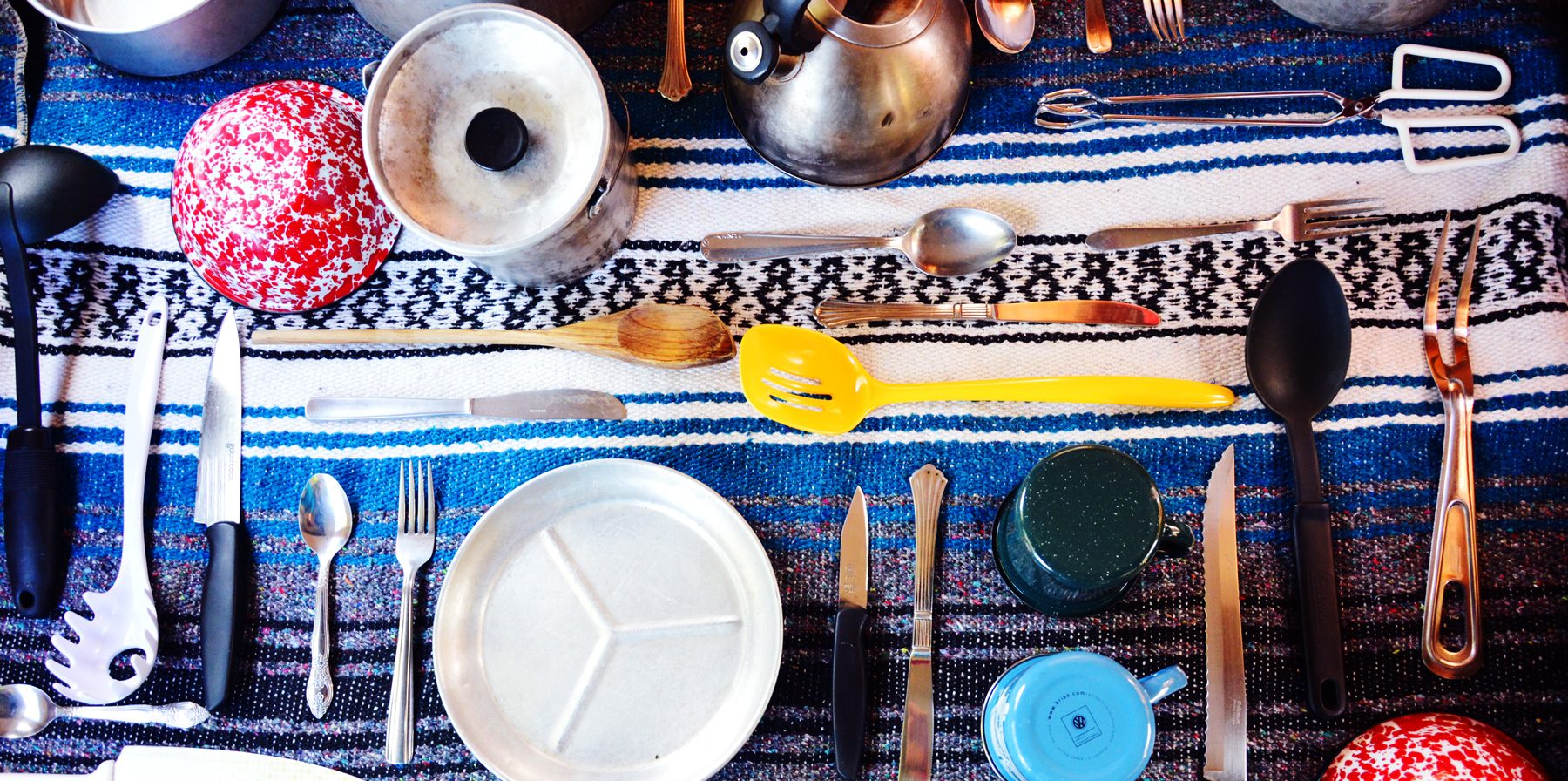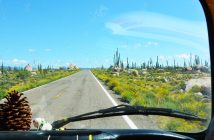When I was in my tweens, I used to spend hours playing Tetris. It was on one of those ancient Gameboys, the gray ones with the purple buttons and the greenish screens, really old-school. What I never knew was that this skill would be vital living in a van. With a tiny home, good organization is the key to staying sane.
We live in Big Emma, a VW Bus. We have about 80 square feet of living space (about 7.5 square meters). That is not a lot of room to store everything you will need for the next few years. Unlike many other vanlifers, we also have no external storage, no roof box or anything else. This means that we have to store practically everything inside the Bus itself.
Organizing the Bus is a theme of daily life
This also means that organizing inside the Bus is not only incredibly important, it is a theme of daily life. It is so important because it is the only way to fit everything into our Bus at all; it is also constant work preventing that organization from collapsing into chaos.
When we meet other vanlifers, one of the things we talk about is how we organize our respective vans. You step inside and ask questions, peek under the bench to look at something, talk about the inventory of your stuff. Some people have room for things we can’t even begin to think about – bikes strapped on or stored somewhere, or something fancy like a foldable kayak – while we have things others would never dream of taking with them, such as our book collection. Every rig is different, and they are often different sizes and have different features, meaning the topic is always individual. You get a lot of good ideas by looking at what others do with their space.

Our book collection as of December 2016.
Everything in the Bus has its ‘spot’

Our water-tank cabinet. The top shelf contains extra kitchen things and other household items; the middle shelf holds our first-aid kit, fire starters, mosquito coils, and plastic bags of various sizes; the lower shelf contains our stackable pots and Tupperware with small cooking items. Click to expand.
Before we left for our trip, I spent weeks thinking about where I would store everything. I really like organizing stuff. I would put our sleeping bags over here, store our kitchenware in this cabinet, put all of our food in this space. When we actually packed the Bus, a day or so before we left, my plan sort of worked. Most things fit where I was intending them to fit, but often something else had to be stored there as well. I could not afford the luxury of saying “Okay, I will put all of the kitchen things here, and only here.” The puzzle of fitting everything we needed in our Bus didn’t work like that.
I wanted, for example, to use the top shelf of our “water-tank cabinet” to store extra kitchen stuff like our coffee press, sugar supply, and olive oil. But there was a lot more space on that shelf, which means it does not only hold kitchen stuff, but lots of other random things as well.
Now, that one shelf is home to our French press, vegetable oil, citronella candle, two candles in mason jars that we can hang inside our Bus, charcoal, tea and cocoa bags, two coils of rope, honey, the hot water bottle, and the sugar tin. I couldn’t just make it for kitchen things, because all this other stuff had to go somewhere, and that is where they fit. I guess I can call that shelf now more like “extra kitchen things and other household items”. But as much as my organizational feng shui says that this shelf should be for kitchen things only, that is not possible in such a tiny space.
Which leads to the fact that everything in the Bus has its spot. It is not always the logical one (who would think to find rope behind the coffee maker?), but we know exactly where it is. When we don’t put things back where they have always been, we lose them, even in just 80 square feet of space. At the moment, we seemed to have misplaced one of our four camping mugs, for example. I wonder where it went.
We play Tetris, with real pieces
In many cases, things only fit one exact way, and can only be put away in a specific order. On the lower shelf of the water-tank cabinet, for example, sit exactly two things: our stackable pots and pans, and the small layered Tupperware that hold small cooking gear like our can-opener, spices, bottle openers, lighters, etc. Whenever we want to access the stacked pots, we have to remove the Tupperware. It doesn’t fit any other way. I’m sure there is a space in your house or apartment that works like this, too. In our Bus, this is everywhere.
This means we are moving things around all the time. For example, when I am sitting on our bench seat and Sven on our box seat, which is lodged between our water-tank cabinet and our big cabinet, he has to get up to get to our stove, which is stored on the middle shelf in the big cabinet. After he has sat back down, and we’ve realized we’ve forgotten to get out the pasta we would like to cook, he has to get up again, move the box seat, and access the same cabinet again. Now imagine that it is raining outside and there are four people in our Bus at a time, or even six – and there is no room for Sven to stand in until somebody moves. This is what we call Playing Tetris. It is all about putting the pieces in the exact right spot, in the right order, all the time.
And if we do not, chaos will quickly ensue. There is no room to leave things lying around, because there is no place to put the thing you need next if every available spot is already covered by something else. And there are not that many available spots in the first place. This means we have to put things away after we are done, and everybody in the Bus has to participate. If I can’t get to our silverware because you are in the way, the only thing to do is ask you to move (or forsake the silverware).
Tired? Fold the bench into a bed by sliding left or right!
So, what do we have in our Bus?

The wheel on a two-by-four to avoid angled sleeping. Don’t worry, our tire isn’t flat!
First of all, many things in our Bus have multiple uses. Some very basic examples involve how VW campers are usually built: our bench seat also turns into our bed, and our top is both extra storage for the night and a guest bedroom. But there are many other instances where things double their usage as well. We use our two ‘boxes’ as seats around a campfire; we also use one to hold all of our shoes, and the other to hold big books and our VW repair manuals. Another example are the four small two-by-four boards that we keep underneath our bench seat. We bought them to put under our car jack to make it higher (it doesn’t reach some of our jack points under the car if we don’t), and we also use them to level out the car when we park at night by driving onto them. Sleeping in an angled vehicle sucks.
We have a lot of stuff. We have silverware, plates, and cups (hmm….I still wonder where the fourth one went….) for four people; we are always equipped for guests. We have two pans, and three stackable pots. We have 28 paper books. I have five pairs of shoes, Sven has three and some broken flip flops (we should get rid of those). I have two coats, Sven has three, and all of them are stuffed behind the passenger’s seat. All of our clothes are stored in boxes in what the VW community calls “the headbanger cabinet” – the one that hangs above our bed and is especially dangerous in the morning or the dark. In the headbanger cabinet, I have nine boxes, Sven has six (lucky me). In addition to this, we store warm clothing like sweatshirts and comfy pants, winter hats and gloves, and Underarmor in various other places around the Bus.
All of our large items can be stored in only two places: underneath the bench (where we keep our breaker bar, saw, ax, grill, backpacks, hammock, tent, two-by-fours, slackline, and lots of other stuff) and in the tub on top of the driver’s cab in the front of the Bus, where our roof doesn’t pop and that constantly gets wet (where we keep our extra camping chair, tarps, jack, emergency triangle, and 10 gallons of extra gas). We also try to hang anything we can from the bungee cords that we have attached to the ceiling inside our Bus, such as dish towels, small wet things, our sponge, Sven’s bow tie, and extra water containers for when we filter our water from streams.

Box seat, which contains our shoes. I have five pairs, Sven has three, plus a broken pair of flip flops.
Food is hard to store. My pre-trip naive self thought it could all go on the single shelf in the big cabinet. Now, we also store food in the box that is bungee-corded to sit on the counter of the big cabinet behind the driver’s seat, as well as a very large box between the two front seats. We will get rid of that one soon, when we buy a propane tank before we go to Central America. That is the only spot where it will fit well. I don’t know where we will store all of our extra food yet.
One of the most important places in Big Emma is underneath what we call the “bitch seat” – this is where all of our tools for fixing and caring for the Bus are stored. These are absolutely essential, and there is a surprising amount of room underneath that seat. Most of our spare parts (and we have quite a few) are stored in the spare wheel well underneath the bed. Also worth mentioning is my naive strategy before we left to make sure nothing is around on the floor while we drive, that everything can actually be stored somewhere. Sadly, however, crap piles up.
Also worth mentioning is my naive strategy before we left to make sure nothing is around on the floor while we drive, that everything can actually be stored somewhere. Sadly, however, crap piles up. Currently, we have our extra 5-gallon water jug, our small heater, occasionally beer, our foldable wash basin (where we keep our dirty dishes if we haven’t done them yet), our Thermos, and a surfboard lying around on the floor of the Bus while we drive. These are usually packed to the front when we stop to sleep for the night.
Of course, there are many, many other things in our Bus besides those I have mentioned here, but that would make this post unnecessarily long. And I believe you get the picture.
If you have any more organizational questions for us, please feel free to shoot us a comment below!







